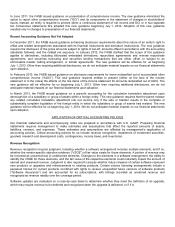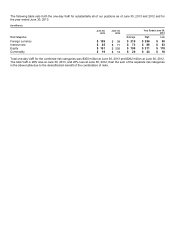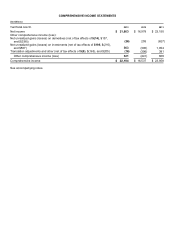Microsoft 2013 Annual Report Download - page 36
Download and view the complete annual report
Please find page 36 of the 2013 Microsoft annual report below. You can navigate through the pages in the report by either clicking on the pages listed below, or by using the keyword search tool below to find specific information within the annual report.
In June 2011, the FASB issued guidance on presentation of comprehensive income. The new guidance eliminated the
option to report other comprehensive income (“OCI”) and its components in the statement of changes in stockholders’
equity. Instead, an entity is required to present either a continuous statement of net income and OCI or in two separate
but consecutive statements. We adopted this new guidance beginning July 1, 2012. Adoption of this new guidance
resulted only in changes to presentation of our financial statements.
Recent Accounting Guidance Not Yet Adopted
In December 2011, the FASB issued guidance enhancing disclosure requirements about the nature of an entity’s right to
offset and related arrangements associated with its financial instruments and derivative instruments. The new guidance
requires the disclosure of the gross amounts subject to rights of set-off, amounts offset in accordance with the accounting
standards followed, and the related net exposure. In January 2013, the FASB clarified that the scope of this guidance
applies to derivatives, including bifurcated embedded derivatives, repurchase agreements and reverse repurchase
agreements, and securities borrowing and securities lending transactions that are either offset or subject to an
enforceable master netting arrangement, or similar agreements. The new guidance will be effective for us beginning
July 1, 2013. Other than requiring additional disclosures, we do not anticipate material impacts on our financial statements
upon adoption.
In February 2013, the FASB issued guidance on disclosure requirements for items reclassified out of accumulated other
comprehensive income (“AOCI”). This new guidance requires entities to present (either on the face of the income
statement or in the notes) the effects on the line items of the income statement for amounts reclassified out of AOCI. The
new guidance will be effective for us beginning July 1, 2013. Other than requiring additional disclosures, we do not
anticipate material impacts on our financial statements upon adoption.
In March 2013, the FASB issued guidance on a parent’s accounting for the cumulative translation adjustment upon
derecognition of a subsidiary or group of assets within a foreign entity. This new guidance requires that the parent release
any related cumulative translation adjustment into net income only if the sale or transfer results in the complete or
substantially complete liquidation of the foreign entity in which the subsidiary or group of assets had resided. The new
guidance will be effective for us beginning July 1, 2014. We do not anticipate material impacts on our financial statements
upon adoption.
APPLICATION OF CRITICAL ACCOUNTING POLICIES
Our financial statements and accompanying notes are prepared in accordance with U.S. GAAP. Preparing financial
statements requires management to make estimates and assumptions that affect the reported amounts of assets,
liabilities, revenue, and expenses. These estimates and assumptions are affected by management’s application of
accounting policies. Critical accounting policies for us include revenue recognition, impairment of investment securities,
goodwill, research and development costs, contingencies, income taxes, and inventories.
Revenue Recognition
Revenue recognition requires judgment, including whether a software arrangement includes multiple elements, and if so,
whether the vendor-specific objective evidence (“VSOE”) of fair value exists for those elements. A portion of revenue may
be recorded as unearned due to undelivered elements. Changes to the elements in a software arrangement, the ability to
identify the VSOE for those elements, and the fair value of the respective elements could materially impact the amount of
earned and unearned revenue. Judgment is also required to assess whether future releases of certain software represent
new products or upgrades and enhancements to existing products. Certain volume licensing arrangements include a
perpetual license for current products combined with rights to receive unspecified future versions of software products
(“Software Assurance”) and are accounted for as subscriptions, with billings recorded as unearned revenue and
recognized as revenue ratably over the coverage period.
Software updates are evaluated on a case-by-case basis to determine whether they meet the definition of an upgrade,
which may require revenue to be deferred and recognized when the upgrade is delivered, or if it is
























